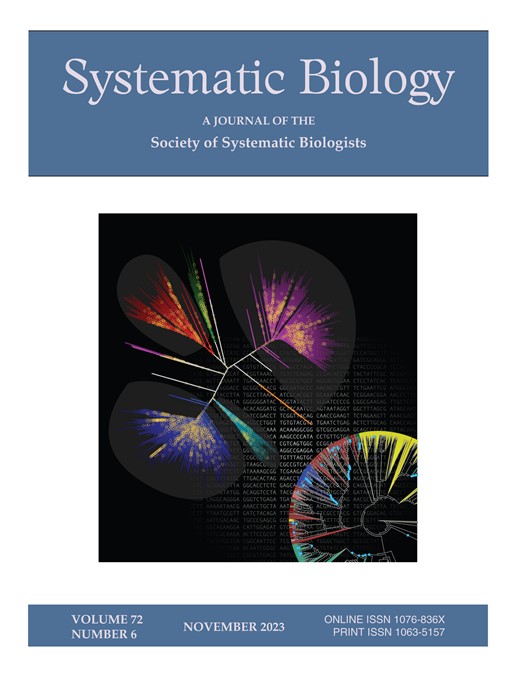Evolutionary Tempo, Supertaxa and Living Fossils
IF 5.7
1区 生物学
Q1 EVOLUTIONARY BIOLOGY
引用次数: 0
Abstract
A relationship between the rate of molecular change and diversification has long been, discussed, on both theoretical and empirical grounds. However, the effect on our, understanding of evolutionary patterns is yet to be fully explored. Here we develop a new, model, the Covariant Evolutionary Tempo (CET) model, with the aim of integrating, patterns of diversification and molecular evolution within a framework of a continuously, changing ‘tempo’ variable that acts as a master control for molecular, morphological and, diversification rates. Importantly, tempo itself is treated as being variable at a rate, proportional to its own value. This model predicts that diversity is dominated by a small, number of extremely large clades at any historical epoch including the present; that these, large clades are expected to be characterised by explosive early radiations accompanied by, elevated rates of molecular evolution; and that extant organisms are likely to have evolved, from species with unusually fast evolutionary rates. Under such a model, the amount of, molecular change along a particular lineage is essentially independent of its height, which, weakens the molecular clock hypothesis. Finally, our model explains the existence of ‘living, fossil’ sister groups to large clades that are species poor and exhibit slow rates of, morphological and molecular change. Our results demonstrate that the observed historical, patterns of evolution can be modelled without invoking special evolutionary mechanisms or, innovations that are unique to specific times or taxa, even when they are highly, non-uniform进化速度,超级分类群和活化石
分子变化率和多样化之间的关系,早已在理论和经验的基础上讨论过。然而,对我们理解进化模式的影响还有待充分探索。在这里,我们开发了一个新的模型,协变进化速度(CET)模型,目的是在一个连续变化的“速度”变量框架内整合多样化和分子进化模式,该变量作为分子、形态和多样化率的主控制。重要的是,节奏本身被认为是可变的,与它自己的值成比例。该模型预测,在包括现在在内的任何历史时期,生物多样性都是由少数极其庞大的进化支主导的;这些大型进化支的特征是早期的爆炸性辐射,同时伴随着分子进化的加快;现存的生物很可能是从进化速度异常快的物种进化而来的。在这种模型下,沿着一个特定谱系的分子变化量基本上与它的高度无关,这削弱了分子钟假说。最后,我们的模型解释了“活的,化石的”姐妹群的存在,这些姐妹群是物种贫乏的,表现出缓慢的形态和分子变化速率。我们的研究结果表明,观察到的历史进化模式可以被建模,而不需要调用特殊的进化机制或特定时代或分类群特有的创新,即使它们高度不均匀
本文章由计算机程序翻译,如有差异,请以英文原文为准。
求助全文
约1分钟内获得全文
求助全文
来源期刊

Systematic Biology
生物-进化生物学
CiteScore
13.00
自引率
7.70%
发文量
70
审稿时长
6-12 weeks
期刊介绍:
Systematic Biology is the bimonthly journal of the Society of Systematic Biologists. Papers for the journal are original contributions to the theory, principles, and methods of systematics as well as phylogeny, evolution, morphology, biogeography, paleontology, genetics, and the classification of all living things. A Points of View section offers a forum for discussion, while book reviews and announcements of general interest are also featured.
 求助内容:
求助内容: 应助结果提醒方式:
应助结果提醒方式:


